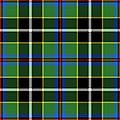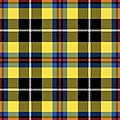Cornish_national_tartan
Cornish kilts and tartans are thought to be a modern tradition started in the early to mid 20th century. The first modern kilt was plain black, and other patterns followed. It is documented that a garment known as a bracca (a reddish checkered tunic) was worn by Celtic people (There were no people called 'Celts' The term 'Celts' is a modern 18th century notion derived from the similarities in what are known as the Celtic languages - spoken extensively in Ireland, Scotland, Wales, Man, Cornwall and Brittany, in the past).[1] yet the term Celtae/Galatae was an ethonym of the Gallic peoples according to Greeks and Romans, whom shared a common language route with the what is termed Insular Celtic people in academia. who inhabited the British Isles, the term indicating its appearance.[2] The Welsh word brech means 'checkered' (compare the cognate Scottish Gaelic breac, 'variegated, freckled'), and the word bracca is derived from the Welsh or Cornish word brythen which in English translates as 'striped' or 'checkered'.[3]
Cornish historian L. C. R. Duncombe-Jewell attempted to prove that plain kilts were in use in Cornwall. He discovered carvings of minstrels dressed in what he interpreted as kilts and playing bagpipes on bench ends at Altarnun church, which dated from circa 1510.[4][5] The earliest historical reference to the Cornish kilt is from 1903, when the aforementioned Duncombe-Jewell appeared in a woad-blue kilt as the Cornish delegate to the Celtic Congress, convening at Caernarvon. John T. Koch in his work Celtic Culture: A Historical Encyclopedia mentions a black kilt worn by the Duke of Cornwall's Light Infantry in combat; however, no historical reference is provided to support this claim.





